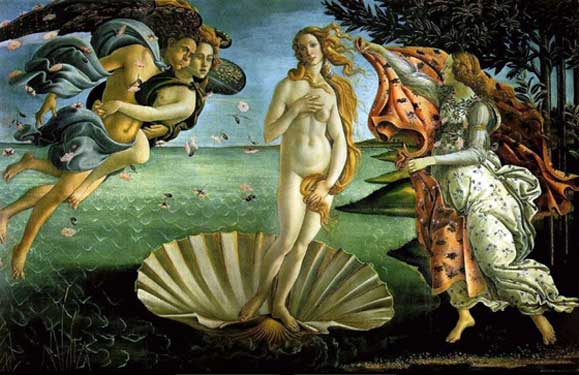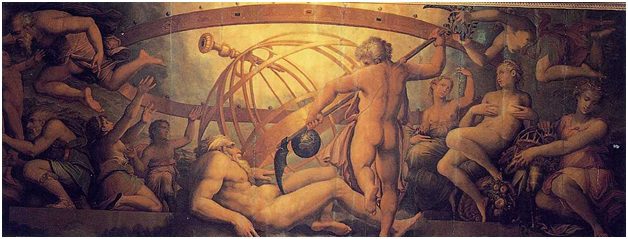
Sandro Boticelli
Uffizi Gallery, Florence, Italy
The goddess of love, lust, and lasciviousness, Aphrodite (Venus) rose naked from the sea, her DNA reputedly derived from the discarded organs of her cruelly gelded grandfather Uranus. Each year she is admired in her dishabille by throngs of tourist visiting the Uffizi museum in Florence.
In one of several contradictory legends, Uranus (Roman Saturn, Father Sky), hated his children and imprisoned the youngest ones deep in the earth, in Tartarus, where they cause pain to Gaea, Mother Earth, his wife and according to some also his mother. As Gaea resented this she begged her sons to deal with Uranus. So the youngest son, Cronos took a sickle and mercilessly castrated Uranus, throwing his testicles into the sea. Aphrodite, the goddess of love was born from the foam of the discarded organs.

Giorgio Vasari and Cristofano Gherardi
Palazzo Vecchio, Florence, Italy
Venus (Aphrodite), the goddess of love and beauty, was the daughter of Jupiter and Dione. Others say that Venus sprang from the foam of the sea. The zephyr wafted her along the waves to the Isle of Cyprus, where she was received and attired by the Seasons, and then led to the assembly of the gods. All were charmed with her beauty, and each one demanded her for his wife. Jupiter gave her to Vulcan, in gratitude for the service he had rendered in forging thunderbolts. So the most beautiful of the goddesses became the wife of the most ill-favored of the gods. Venus possessed an embroidered girdle called the Cestus, which had the power of inspiring love. Her favorite birds were swans and doves, and the plants sacred to her were the rose and the myrtle.
From The Age of Fable by Thomas Bulfinch

Leave a Reply